Myocardial Infarction; Kath Harris Case study
VerifiedAdded on 2023/06/03
|9
|2975
|243
AI Summary
This case study explores the clinical manifestation, management, risk factors and modification of myocardial infarction through the case study of Kath Harris. It also provides statistics on the prevalence and incidence of heart attack in Australia.
Contribute Materials
Your contribution can guide someone’s learning journey. Share your
documents today.
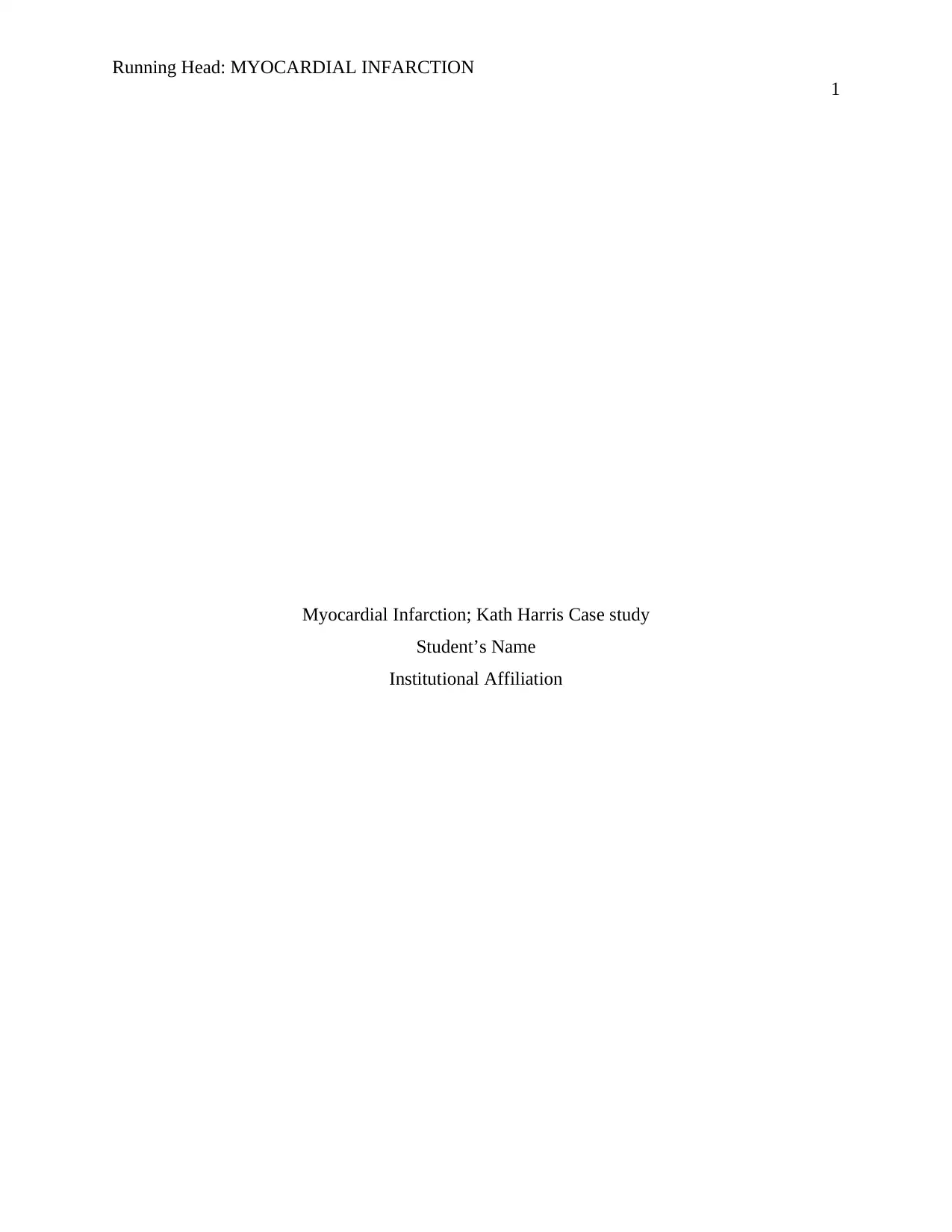
Running Head: MYOCARDIAL INFARCTION
1
Myocardial Infarction; Kath Harris Case study
Student’s Name
Institutional Affiliation
1
Myocardial Infarction; Kath Harris Case study
Student’s Name
Institutional Affiliation
Secure Best Marks with AI Grader
Need help grading? Try our AI Grader for instant feedback on your assignments.
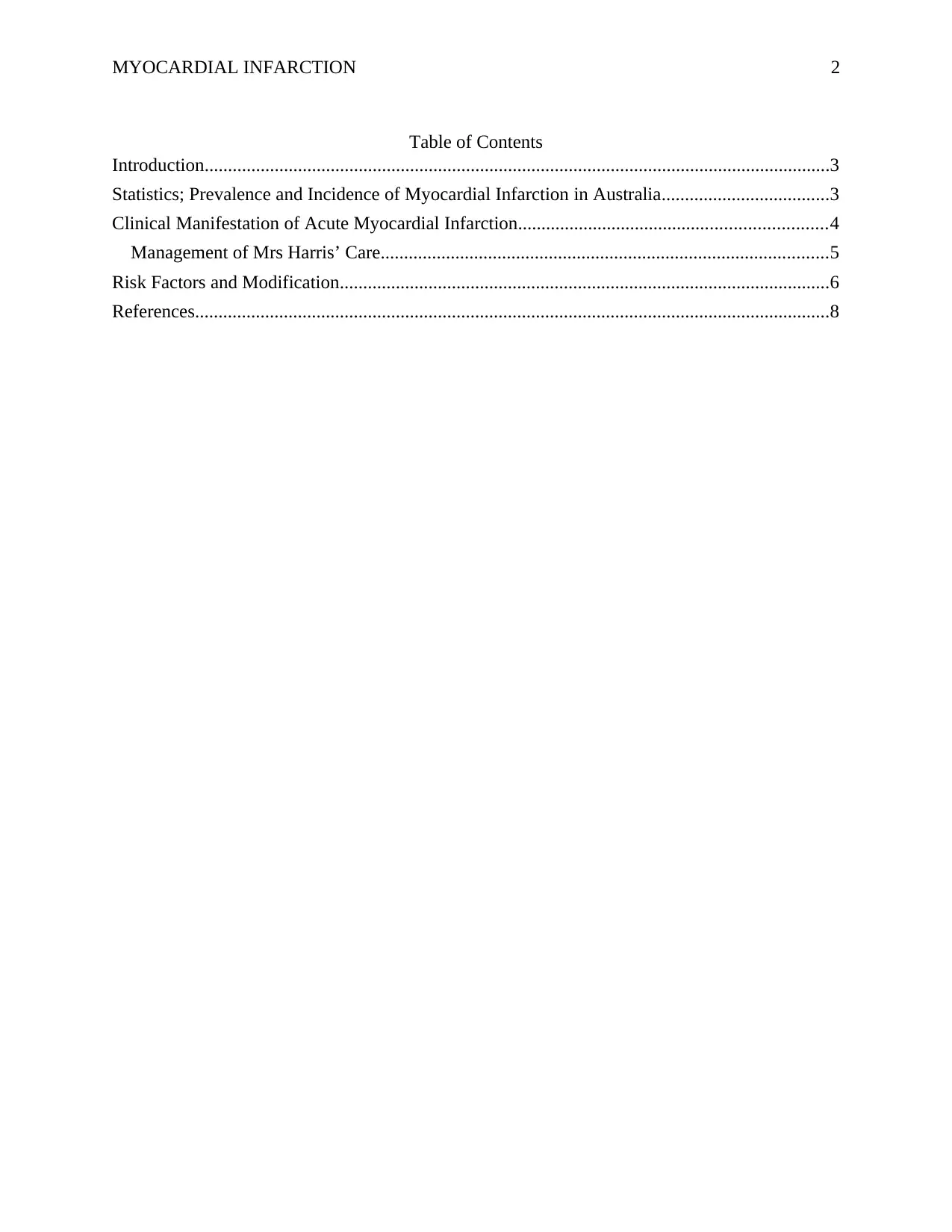
MYOCARDIAL INFARCTION 2
Table of Contents
Introduction......................................................................................................................................3
Statistics; Prevalence and Incidence of Myocardial Infarction in Australia....................................3
Clinical Manifestation of Acute Myocardial Infarction..................................................................4
Management of Mrs Harris’ Care................................................................................................5
Risk Factors and Modification.........................................................................................................6
References........................................................................................................................................8
Table of Contents
Introduction......................................................................................................................................3
Statistics; Prevalence and Incidence of Myocardial Infarction in Australia....................................3
Clinical Manifestation of Acute Myocardial Infarction..................................................................4
Management of Mrs Harris’ Care................................................................................................5
Risk Factors and Modification.........................................................................................................6
References........................................................................................................................................8
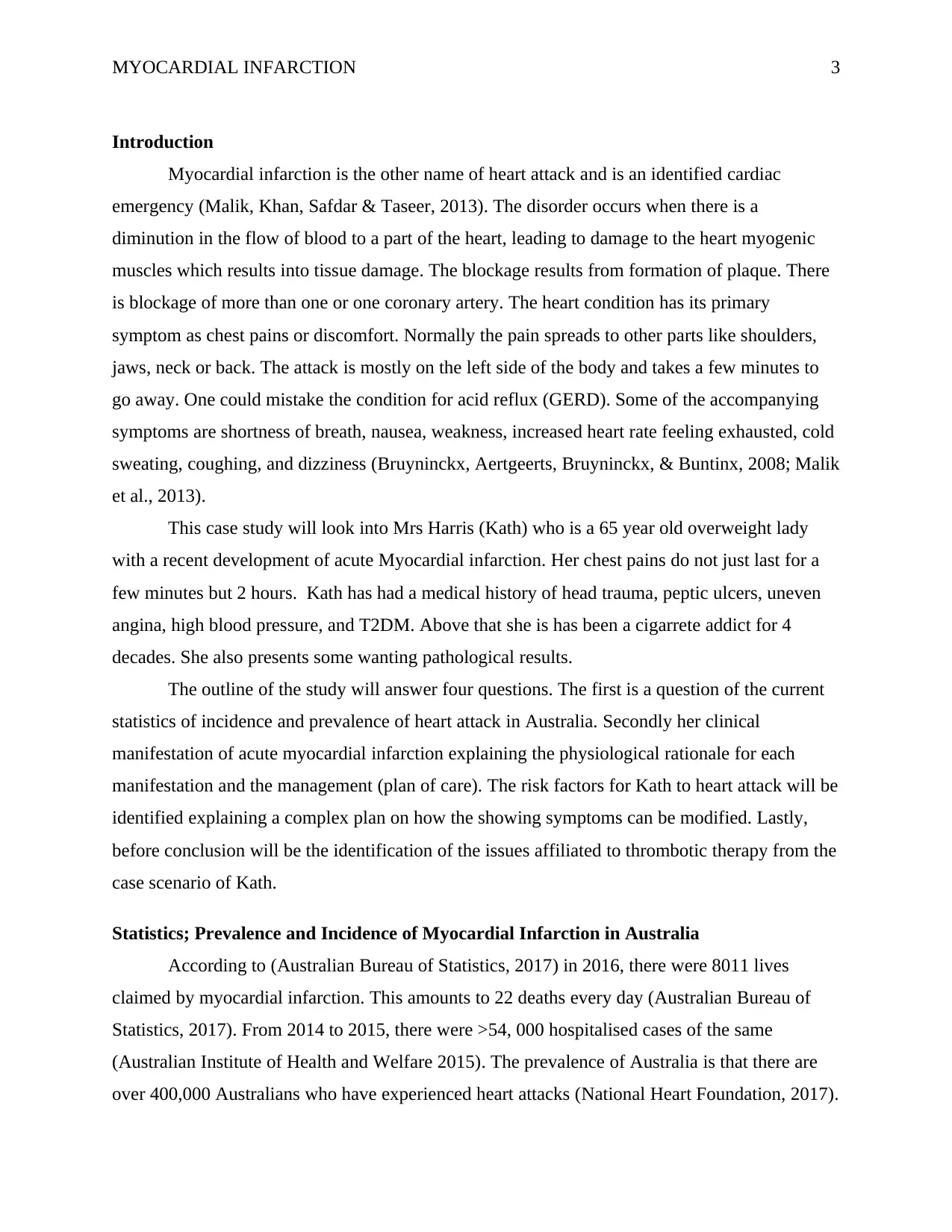
MYOCARDIAL INFARCTION 3
Introduction
Myocardial infarction is the other name of heart attack and is an identified cardiac
emergency (Malik, Khan, Safdar & Taseer, 2013). The disorder occurs when there is a
diminution in the flow of blood to a part of the heart, leading to damage to the heart myogenic
muscles which results into tissue damage. The blockage results from formation of plaque. There
is blockage of more than one or one coronary artery. The heart condition has its primary
symptom as chest pains or discomfort. Normally the pain spreads to other parts like shoulders,
jaws, neck or back. The attack is mostly on the left side of the body and takes a few minutes to
go away. One could mistake the condition for acid reflux (GERD). Some of the accompanying
symptoms are shortness of breath, nausea, weakness, increased heart rate feeling exhausted, cold
sweating, coughing, and dizziness (Bruyninckx, Aertgeerts, Bruyninckx, & Buntinx, 2008; Malik
et al., 2013).
This case study will look into Mrs Harris (Kath) who is a 65 year old overweight lady
with a recent development of acute Myocardial infarction. Her chest pains do not just last for a
few minutes but 2 hours. Kath has had a medical history of head trauma, peptic ulcers, uneven
angina, high blood pressure, and T2DM. Above that she is has been a cigarrete addict for 4
decades. She also presents some wanting pathological results.
The outline of the study will answer four questions. The first is a question of the current
statistics of incidence and prevalence of heart attack in Australia. Secondly her clinical
manifestation of acute myocardial infarction explaining the physiological rationale for each
manifestation and the management (plan of care). The risk factors for Kath to heart attack will be
identified explaining a complex plan on how the showing symptoms can be modified. Lastly,
before conclusion will be the identification of the issues affiliated to thrombotic therapy from the
case scenario of Kath.
Statistics; Prevalence and Incidence of Myocardial Infarction in Australia
According to (Australian Bureau of Statistics, 2017) in 2016, there were 8011 lives
claimed by myocardial infarction. This amounts to 22 deaths every day (Australian Bureau of
Statistics, 2017). From 2014 to 2015, there were >54, 000 hospitalised cases of the same
(Australian Institute of Health and Welfare 2015). The prevalence of Australia is that there are
over 400,000 Australians who have experienced heart attacks (National Heart Foundation, 2017).
Introduction
Myocardial infarction is the other name of heart attack and is an identified cardiac
emergency (Malik, Khan, Safdar & Taseer, 2013). The disorder occurs when there is a
diminution in the flow of blood to a part of the heart, leading to damage to the heart myogenic
muscles which results into tissue damage. The blockage results from formation of plaque. There
is blockage of more than one or one coronary artery. The heart condition has its primary
symptom as chest pains or discomfort. Normally the pain spreads to other parts like shoulders,
jaws, neck or back. The attack is mostly on the left side of the body and takes a few minutes to
go away. One could mistake the condition for acid reflux (GERD). Some of the accompanying
symptoms are shortness of breath, nausea, weakness, increased heart rate feeling exhausted, cold
sweating, coughing, and dizziness (Bruyninckx, Aertgeerts, Bruyninckx, & Buntinx, 2008; Malik
et al., 2013).
This case study will look into Mrs Harris (Kath) who is a 65 year old overweight lady
with a recent development of acute Myocardial infarction. Her chest pains do not just last for a
few minutes but 2 hours. Kath has had a medical history of head trauma, peptic ulcers, uneven
angina, high blood pressure, and T2DM. Above that she is has been a cigarrete addict for 4
decades. She also presents some wanting pathological results.
The outline of the study will answer four questions. The first is a question of the current
statistics of incidence and prevalence of heart attack in Australia. Secondly her clinical
manifestation of acute myocardial infarction explaining the physiological rationale for each
manifestation and the management (plan of care). The risk factors for Kath to heart attack will be
identified explaining a complex plan on how the showing symptoms can be modified. Lastly,
before conclusion will be the identification of the issues affiliated to thrombotic therapy from the
case scenario of Kath.
Statistics; Prevalence and Incidence of Myocardial Infarction in Australia
According to (Australian Bureau of Statistics, 2017) in 2016, there were 8011 lives
claimed by myocardial infarction. This amounts to 22 deaths every day (Australian Bureau of
Statistics, 2017). From 2014 to 2015, there were >54, 000 hospitalised cases of the same
(Australian Institute of Health and Welfare 2015). The prevalence of Australia is that there are
over 400,000 Australians who have experienced heart attacks (National Heart Foundation, 2017).
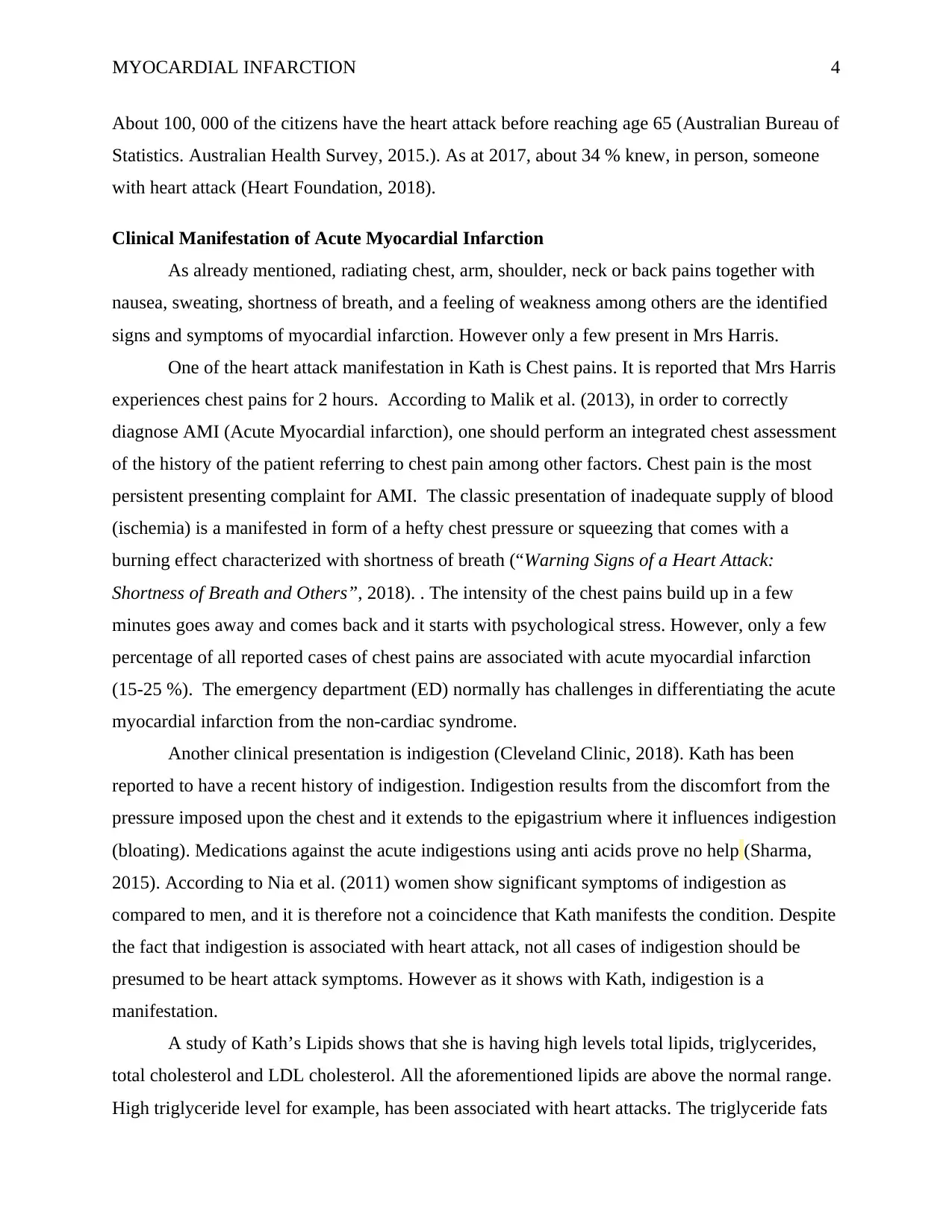
MYOCARDIAL INFARCTION 4
About 100, 000 of the citizens have the heart attack before reaching age 65 (Australian Bureau of
Statistics. Australian Health Survey, 2015.). As at 2017, about 34 % knew, in person, someone
with heart attack (Heart Foundation, 2018).
Clinical Manifestation of Acute Myocardial Infarction
As already mentioned, radiating chest, arm, shoulder, neck or back pains together with
nausea, sweating, shortness of breath, and a feeling of weakness among others are the identified
signs and symptoms of myocardial infarction. However only a few present in Mrs Harris.
One of the heart attack manifestation in Kath is Chest pains. It is reported that Mrs Harris
experiences chest pains for 2 hours. According to Malik et al. (2013), in order to correctly
diagnose AMI (Acute Myocardial infarction), one should perform an integrated chest assessment
of the history of the patient referring to chest pain among other factors. Chest pain is the most
persistent presenting complaint for AMI. The classic presentation of inadequate supply of blood
(ischemia) is a manifested in form of a hefty chest pressure or squeezing that comes with a
burning effect characterized with shortness of breath (“Warning Signs of a Heart Attack:
Shortness of Breath and Others”, 2018). . The intensity of the chest pains build up in a few
minutes goes away and comes back and it starts with psychological stress. However, only a few
percentage of all reported cases of chest pains are associated with acute myocardial infarction
(15-25 %). The emergency department (ED) normally has challenges in differentiating the acute
myocardial infarction from the non-cardiac syndrome.
Another clinical presentation is indigestion (Cleveland Clinic, 2018). Kath has been
reported to have a recent history of indigestion. Indigestion results from the discomfort from the
pressure imposed upon the chest and it extends to the epigastrium where it influences indigestion
(bloating). Medications against the acute indigestions using anti acids prove no help (Sharma,
2015). According to Nia et al. (2011) women show significant symptoms of indigestion as
compared to men, and it is therefore not a coincidence that Kath manifests the condition. Despite
the fact that indigestion is associated with heart attack, not all cases of indigestion should be
presumed to be heart attack symptoms. However as it shows with Kath, indigestion is a
manifestation.
A study of Kath’s Lipids shows that she is having high levels total lipids, triglycerides,
total cholesterol and LDL cholesterol. All the aforementioned lipids are above the normal range.
High triglyceride level for example, has been associated with heart attacks. The triglyceride fats
About 100, 000 of the citizens have the heart attack before reaching age 65 (Australian Bureau of
Statistics. Australian Health Survey, 2015.). As at 2017, about 34 % knew, in person, someone
with heart attack (Heart Foundation, 2018).
Clinical Manifestation of Acute Myocardial Infarction
As already mentioned, radiating chest, arm, shoulder, neck or back pains together with
nausea, sweating, shortness of breath, and a feeling of weakness among others are the identified
signs and symptoms of myocardial infarction. However only a few present in Mrs Harris.
One of the heart attack manifestation in Kath is Chest pains. It is reported that Mrs Harris
experiences chest pains for 2 hours. According to Malik et al. (2013), in order to correctly
diagnose AMI (Acute Myocardial infarction), one should perform an integrated chest assessment
of the history of the patient referring to chest pain among other factors. Chest pain is the most
persistent presenting complaint for AMI. The classic presentation of inadequate supply of blood
(ischemia) is a manifested in form of a hefty chest pressure or squeezing that comes with a
burning effect characterized with shortness of breath (“Warning Signs of a Heart Attack:
Shortness of Breath and Others”, 2018). . The intensity of the chest pains build up in a few
minutes goes away and comes back and it starts with psychological stress. However, only a few
percentage of all reported cases of chest pains are associated with acute myocardial infarction
(15-25 %). The emergency department (ED) normally has challenges in differentiating the acute
myocardial infarction from the non-cardiac syndrome.
Another clinical presentation is indigestion (Cleveland Clinic, 2018). Kath has been
reported to have a recent history of indigestion. Indigestion results from the discomfort from the
pressure imposed upon the chest and it extends to the epigastrium where it influences indigestion
(bloating). Medications against the acute indigestions using anti acids prove no help (Sharma,
2015). According to Nia et al. (2011) women show significant symptoms of indigestion as
compared to men, and it is therefore not a coincidence that Kath manifests the condition. Despite
the fact that indigestion is associated with heart attack, not all cases of indigestion should be
presumed to be heart attack symptoms. However as it shows with Kath, indigestion is a
manifestation.
A study of Kath’s Lipids shows that she is having high levels total lipids, triglycerides,
total cholesterol and LDL cholesterol. All the aforementioned lipids are above the normal range.
High triglyceride level for example, has been associated with heart attacks. The triglyceride fats
Secure Best Marks with AI Grader
Need help grading? Try our AI Grader for instant feedback on your assignments.
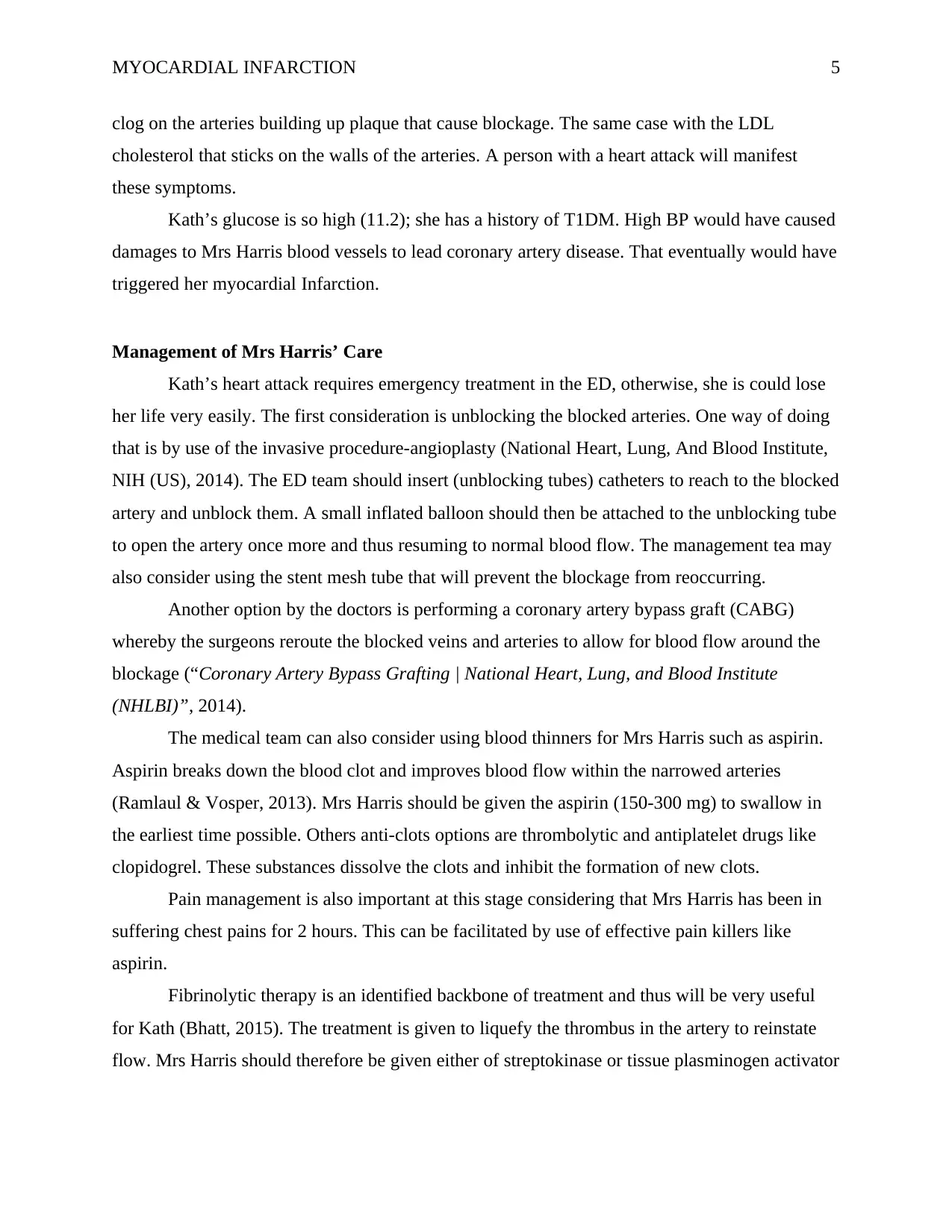
MYOCARDIAL INFARCTION 5
clog on the arteries building up plaque that cause blockage. The same case with the LDL
cholesterol that sticks on the walls of the arteries. A person with a heart attack will manifest
these symptoms.
Kath’s glucose is so high (11.2); she has a history of T1DM. High BP would have caused
damages to Mrs Harris blood vessels to lead coronary artery disease. That eventually would have
triggered her myocardial Infarction.
Management of Mrs Harris’ Care
Kath’s heart attack requires emergency treatment in the ED, otherwise, she is could lose
her life very easily. The first consideration is unblocking the blocked arteries. One way of doing
that is by use of the invasive procedure-angioplasty (National Heart, Lung, And Blood Institute,
NIH (US), 2014). The ED team should insert (unblocking tubes) catheters to reach to the blocked
artery and unblock them. A small inflated balloon should then be attached to the unblocking tube
to open the artery once more and thus resuming to normal blood flow. The management tea may
also consider using the stent mesh tube that will prevent the blockage from reoccurring.
Another option by the doctors is performing a coronary artery bypass graft (CABG)
whereby the surgeons reroute the blocked veins and arteries to allow for blood flow around the
blockage (“Coronary Artery Bypass Grafting | National Heart, Lung, and Blood Institute
(NHLBI)”, 2014).
The medical team can also consider using blood thinners for Mrs Harris such as aspirin.
Aspirin breaks down the blood clot and improves blood flow within the narrowed arteries
(Ramlaul & Vosper, 2013). Mrs Harris should be given the aspirin (150-300 mg) to swallow in
the earliest time possible. Others anti-clots options are thrombolytic and antiplatelet drugs like
clopidogrel. These substances dissolve the clots and inhibit the formation of new clots.
Pain management is also important at this stage considering that Mrs Harris has been in
suffering chest pains for 2 hours. This can be facilitated by use of effective pain killers like
aspirin.
Fibrinolytic therapy is an identified backbone of treatment and thus will be very useful
for Kath (Bhatt, 2015). The treatment is given to liquefy the thrombus in the artery to reinstate
flow. Mrs Harris should therefore be given either of streptokinase or tissue plasminogen activator
clog on the arteries building up plaque that cause blockage. The same case with the LDL
cholesterol that sticks on the walls of the arteries. A person with a heart attack will manifest
these symptoms.
Kath’s glucose is so high (11.2); she has a history of T1DM. High BP would have caused
damages to Mrs Harris blood vessels to lead coronary artery disease. That eventually would have
triggered her myocardial Infarction.
Management of Mrs Harris’ Care
Kath’s heart attack requires emergency treatment in the ED, otherwise, she is could lose
her life very easily. The first consideration is unblocking the blocked arteries. One way of doing
that is by use of the invasive procedure-angioplasty (National Heart, Lung, And Blood Institute,
NIH (US), 2014). The ED team should insert (unblocking tubes) catheters to reach to the blocked
artery and unblock them. A small inflated balloon should then be attached to the unblocking tube
to open the artery once more and thus resuming to normal blood flow. The management tea may
also consider using the stent mesh tube that will prevent the blockage from reoccurring.
Another option by the doctors is performing a coronary artery bypass graft (CABG)
whereby the surgeons reroute the blocked veins and arteries to allow for blood flow around the
blockage (“Coronary Artery Bypass Grafting | National Heart, Lung, and Blood Institute
(NHLBI)”, 2014).
The medical team can also consider using blood thinners for Mrs Harris such as aspirin.
Aspirin breaks down the blood clot and improves blood flow within the narrowed arteries
(Ramlaul & Vosper, 2013). Mrs Harris should be given the aspirin (150-300 mg) to swallow in
the earliest time possible. Others anti-clots options are thrombolytic and antiplatelet drugs like
clopidogrel. These substances dissolve the clots and inhibit the formation of new clots.
Pain management is also important at this stage considering that Mrs Harris has been in
suffering chest pains for 2 hours. This can be facilitated by use of effective pain killers like
aspirin.
Fibrinolytic therapy is an identified backbone of treatment and thus will be very useful
for Kath (Bhatt, 2015). The treatment is given to liquefy the thrombus in the artery to reinstate
flow. Mrs Harris should therefore be given either of streptokinase or tissue plasminogen activator
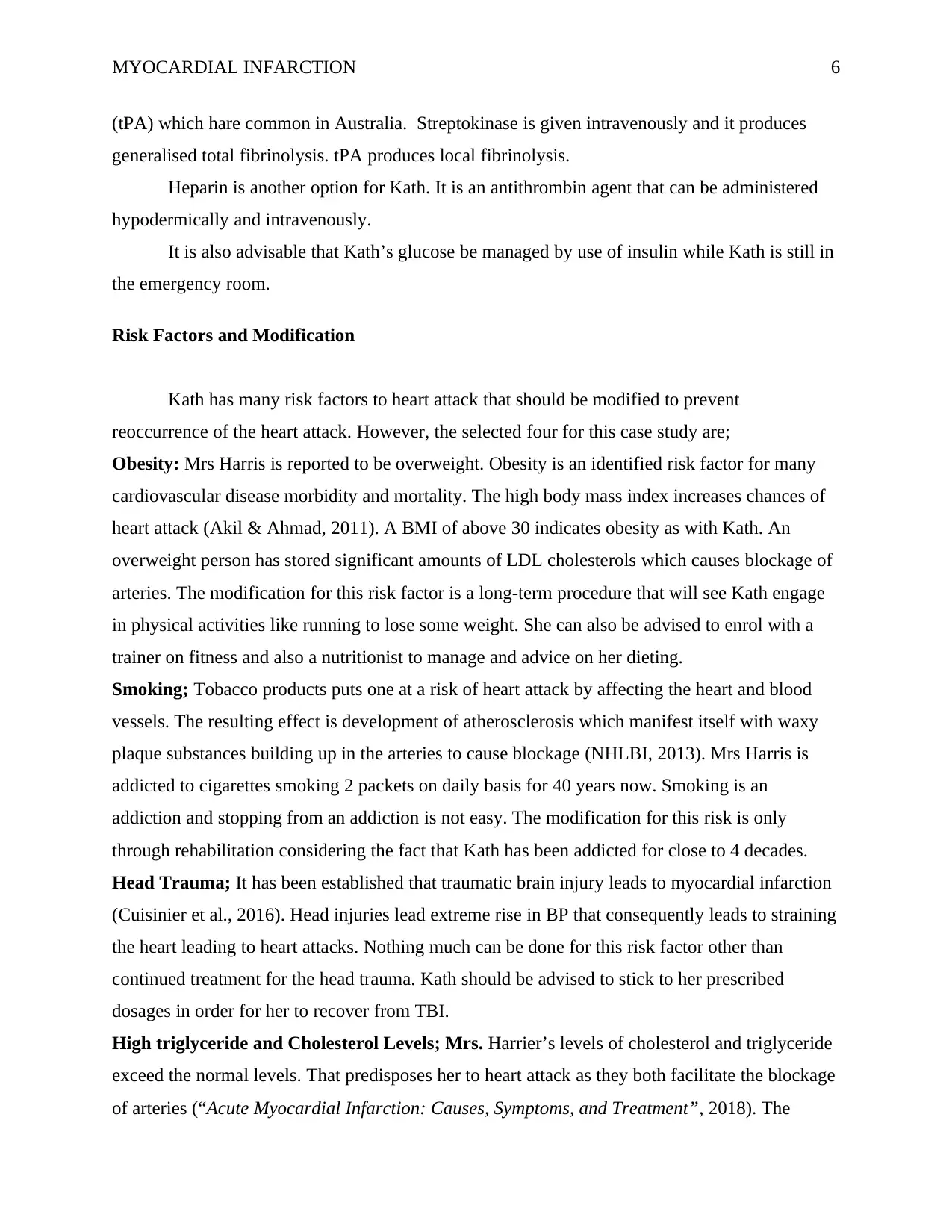
MYOCARDIAL INFARCTION 6
(tPA) which hare common in Australia. Streptokinase is given intravenously and it produces
generalised total fibrinolysis. tPA produces local fibrinolysis.
Heparin is another option for Kath. It is an antithrombin agent that can be administered
hypodermically and intravenously.
It is also advisable that Kath’s glucose be managed by use of insulin while Kath is still in
the emergency room.
Risk Factors and Modification
Kath has many risk factors to heart attack that should be modified to prevent
reoccurrence of the heart attack. However, the selected four for this case study are;
Obesity: Mrs Harris is reported to be overweight. Obesity is an identified risk factor for many
cardiovascular disease morbidity and mortality. The high body mass index increases chances of
heart attack (Akil & Ahmad, 2011). A BMI of above 30 indicates obesity as with Kath. An
overweight person has stored significant amounts of LDL cholesterols which causes blockage of
arteries. The modification for this risk factor is a long-term procedure that will see Kath engage
in physical activities like running to lose some weight. She can also be advised to enrol with a
trainer on fitness and also a nutritionist to manage and advice on her dieting.
Smoking; Tobacco products puts one at a risk of heart attack by affecting the heart and blood
vessels. The resulting effect is development of atherosclerosis which manifest itself with waxy
plaque substances building up in the arteries to cause blockage (NHLBI, 2013). Mrs Harris is
addicted to cigarettes smoking 2 packets on daily basis for 40 years now. Smoking is an
addiction and stopping from an addiction is not easy. The modification for this risk is only
through rehabilitation considering the fact that Kath has been addicted for close to 4 decades.
Head Trauma; It has been established that traumatic brain injury leads to myocardial infarction
(Cuisinier et al., 2016). Head injuries lead extreme rise in BP that consequently leads to straining
the heart leading to heart attacks. Nothing much can be done for this risk factor other than
continued treatment for the head trauma. Kath should be advised to stick to her prescribed
dosages in order for her to recover from TBI.
High triglyceride and Cholesterol Levels; Mrs. Harrier’s levels of cholesterol and triglyceride
exceed the normal levels. That predisposes her to heart attack as they both facilitate the blockage
of arteries (“Acute Myocardial Infarction: Causes, Symptoms, and Treatment”, 2018). The
(tPA) which hare common in Australia. Streptokinase is given intravenously and it produces
generalised total fibrinolysis. tPA produces local fibrinolysis.
Heparin is another option for Kath. It is an antithrombin agent that can be administered
hypodermically and intravenously.
It is also advisable that Kath’s glucose be managed by use of insulin while Kath is still in
the emergency room.
Risk Factors and Modification
Kath has many risk factors to heart attack that should be modified to prevent
reoccurrence of the heart attack. However, the selected four for this case study are;
Obesity: Mrs Harris is reported to be overweight. Obesity is an identified risk factor for many
cardiovascular disease morbidity and mortality. The high body mass index increases chances of
heart attack (Akil & Ahmad, 2011). A BMI of above 30 indicates obesity as with Kath. An
overweight person has stored significant amounts of LDL cholesterols which causes blockage of
arteries. The modification for this risk factor is a long-term procedure that will see Kath engage
in physical activities like running to lose some weight. She can also be advised to enrol with a
trainer on fitness and also a nutritionist to manage and advice on her dieting.
Smoking; Tobacco products puts one at a risk of heart attack by affecting the heart and blood
vessels. The resulting effect is development of atherosclerosis which manifest itself with waxy
plaque substances building up in the arteries to cause blockage (NHLBI, 2013). Mrs Harris is
addicted to cigarettes smoking 2 packets on daily basis for 40 years now. Smoking is an
addiction and stopping from an addiction is not easy. The modification for this risk is only
through rehabilitation considering the fact that Kath has been addicted for close to 4 decades.
Head Trauma; It has been established that traumatic brain injury leads to myocardial infarction
(Cuisinier et al., 2016). Head injuries lead extreme rise in BP that consequently leads to straining
the heart leading to heart attacks. Nothing much can be done for this risk factor other than
continued treatment for the head trauma. Kath should be advised to stick to her prescribed
dosages in order for her to recover from TBI.
High triglyceride and Cholesterol Levels; Mrs. Harrier’s levels of cholesterol and triglyceride
exceed the normal levels. That predisposes her to heart attack as they both facilitate the blockage
of arteries (“Acute Myocardial Infarction: Causes, Symptoms, and Treatment”, 2018). The
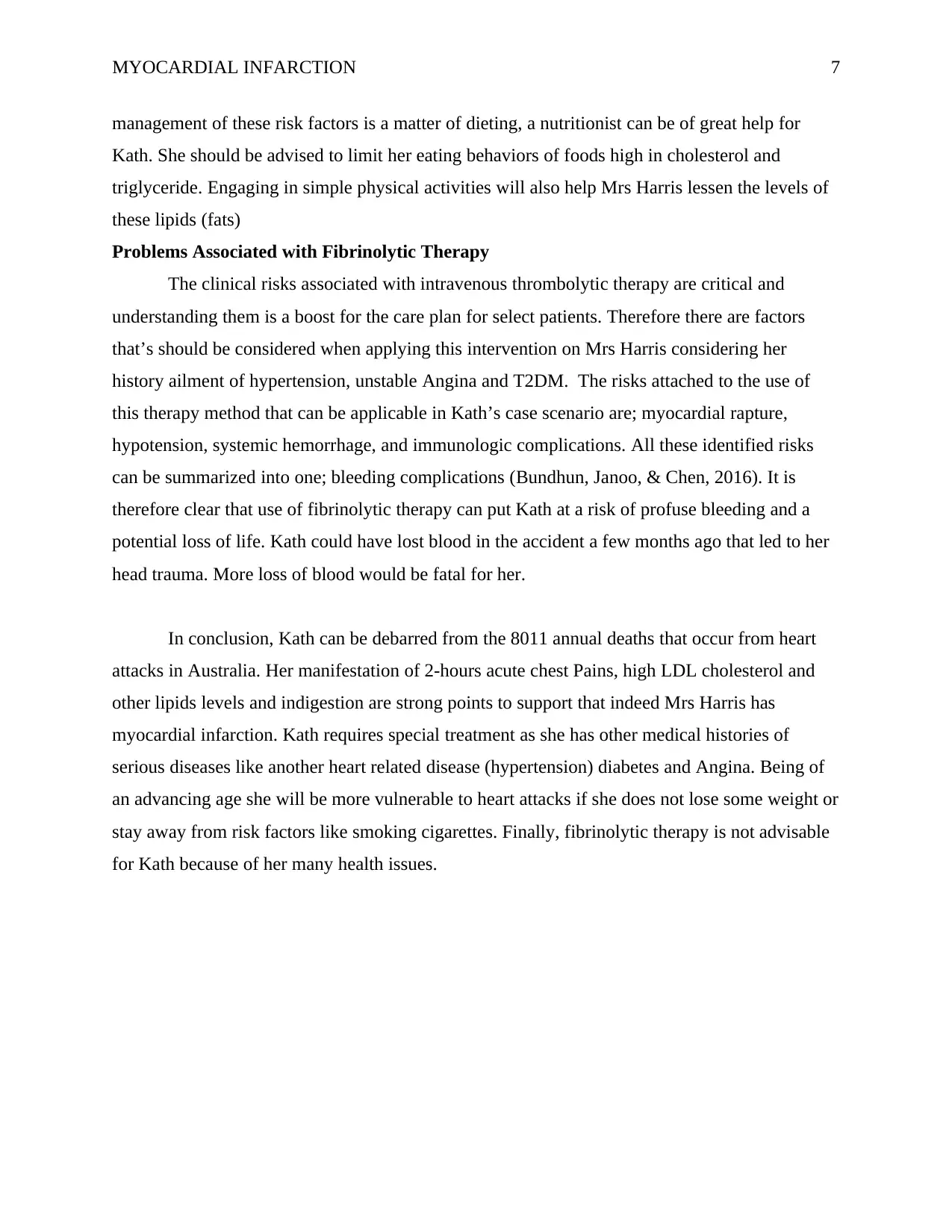
MYOCARDIAL INFARCTION 7
management of these risk factors is a matter of dieting, a nutritionist can be of great help for
Kath. She should be advised to limit her eating behaviors of foods high in cholesterol and
triglyceride. Engaging in simple physical activities will also help Mrs Harris lessen the levels of
these lipids (fats)
Problems Associated with Fibrinolytic Therapy
The clinical risks associated with intravenous thrombolytic therapy are critical and
understanding them is a boost for the care plan for select patients. Therefore there are factors
that’s should be considered when applying this intervention on Mrs Harris considering her
history ailment of hypertension, unstable Angina and T2DM. The risks attached to the use of
this therapy method that can be applicable in Kath’s case scenario are; myocardial rapture,
hypotension, systemic hemorrhage, and immunologic complications. All these identified risks
can be summarized into one; bleeding complications (Bundhun, Janoo, & Chen, 2016). It is
therefore clear that use of fibrinolytic therapy can put Kath at a risk of profuse bleeding and a
potential loss of life. Kath could have lost blood in the accident a few months ago that led to her
head trauma. More loss of blood would be fatal for her.
In conclusion, Kath can be debarred from the 8011 annual deaths that occur from heart
attacks in Australia. Her manifestation of 2-hours acute chest Pains, high LDL cholesterol and
other lipids levels and indigestion are strong points to support that indeed Mrs Harris has
myocardial infarction. Kath requires special treatment as she has other medical histories of
serious diseases like another heart related disease (hypertension) diabetes and Angina. Being of
an advancing age she will be more vulnerable to heart attacks if she does not lose some weight or
stay away from risk factors like smoking cigarettes. Finally, fibrinolytic therapy is not advisable
for Kath because of her many health issues.
management of these risk factors is a matter of dieting, a nutritionist can be of great help for
Kath. She should be advised to limit her eating behaviors of foods high in cholesterol and
triglyceride. Engaging in simple physical activities will also help Mrs Harris lessen the levels of
these lipids (fats)
Problems Associated with Fibrinolytic Therapy
The clinical risks associated with intravenous thrombolytic therapy are critical and
understanding them is a boost for the care plan for select patients. Therefore there are factors
that’s should be considered when applying this intervention on Mrs Harris considering her
history ailment of hypertension, unstable Angina and T2DM. The risks attached to the use of
this therapy method that can be applicable in Kath’s case scenario are; myocardial rapture,
hypotension, systemic hemorrhage, and immunologic complications. All these identified risks
can be summarized into one; bleeding complications (Bundhun, Janoo, & Chen, 2016). It is
therefore clear that use of fibrinolytic therapy can put Kath at a risk of profuse bleeding and a
potential loss of life. Kath could have lost blood in the accident a few months ago that led to her
head trauma. More loss of blood would be fatal for her.
In conclusion, Kath can be debarred from the 8011 annual deaths that occur from heart
attacks in Australia. Her manifestation of 2-hours acute chest Pains, high LDL cholesterol and
other lipids levels and indigestion are strong points to support that indeed Mrs Harris has
myocardial infarction. Kath requires special treatment as she has other medical histories of
serious diseases like another heart related disease (hypertension) diabetes and Angina. Being of
an advancing age she will be more vulnerable to heart attacks if she does not lose some weight or
stay away from risk factors like smoking cigarettes. Finally, fibrinolytic therapy is not advisable
for Kath because of her many health issues.
Paraphrase This Document
Need a fresh take? Get an instant paraphrase of this document with our AI Paraphraser
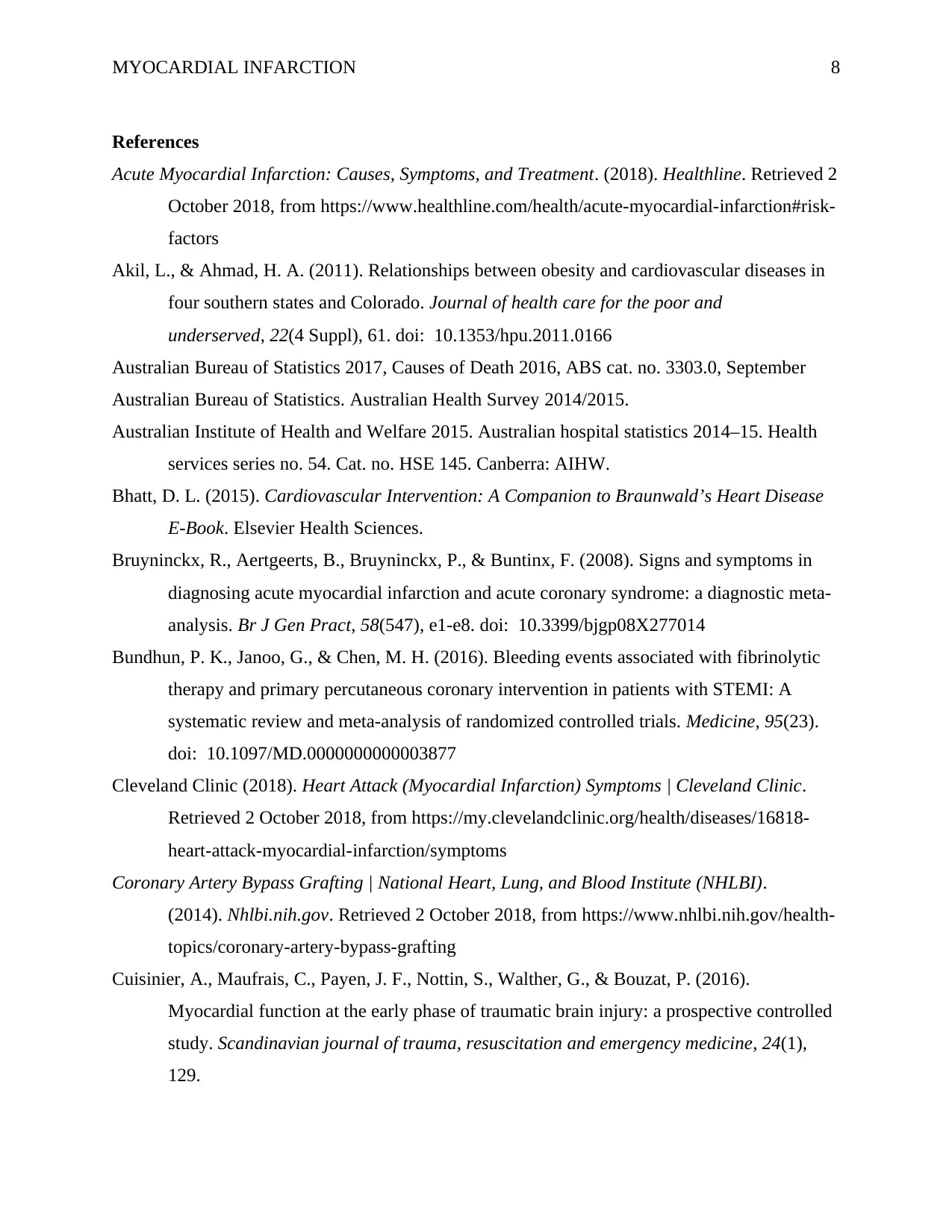
MYOCARDIAL INFARCTION 8
References
Acute Myocardial Infarction: Causes, Symptoms, and Treatment. (2018). Healthline. Retrieved 2
October 2018, from https://www.healthline.com/health/acute-myocardial-infarction#risk-
factors
Akil, L., & Ahmad, H. A. (2011). Relationships between obesity and cardiovascular diseases in
four southern states and Colorado. Journal of health care for the poor and
underserved, 22(4 Suppl), 61. doi: 10.1353/hpu.2011.0166
Australian Bureau of Statistics 2017, Causes of Death 2016, ABS cat. no. 3303.0, September
Australian Bureau of Statistics. Australian Health Survey 2014/2015.
Australian Institute of Health and Welfare 2015. Australian hospital statistics 2014–15. Health
services series no. 54. Cat. no. HSE 145. Canberra: AIHW.
Bhatt, D. L. (2015). Cardiovascular Intervention: A Companion to Braunwald’s Heart Disease
E-Book. Elsevier Health Sciences.
Bruyninckx, R., Aertgeerts, B., Bruyninckx, P., & Buntinx, F. (2008). Signs and symptoms in
diagnosing acute myocardial infarction and acute coronary syndrome: a diagnostic meta-
analysis. Br J Gen Pract, 58(547), e1-e8. doi: 10.3399/bjgp08X277014
Bundhun, P. K., Janoo, G., & Chen, M. H. (2016). Bleeding events associated with fibrinolytic
therapy and primary percutaneous coronary intervention in patients with STEMI: A
systematic review and meta-analysis of randomized controlled trials. Medicine, 95(23).
doi: 10.1097/MD.0000000000003877
Cleveland Clinic (2018). Heart Attack (Myocardial Infarction) Symptoms | Cleveland Clinic.
Retrieved 2 October 2018, from https://my.clevelandclinic.org/health/diseases/16818-
heart-attack-myocardial-infarction/symptoms
Coronary Artery Bypass Grafting | National Heart, Lung, and Blood Institute (NHLBI).
(2014). Nhlbi.nih.gov. Retrieved 2 October 2018, from https://www.nhlbi.nih.gov/health-
topics/coronary-artery-bypass-grafting
Cuisinier, A., Maufrais, C., Payen, J. F., Nottin, S., Walther, G., & Bouzat, P. (2016).
Myocardial function at the early phase of traumatic brain injury: a prospective controlled
study. Scandinavian journal of trauma, resuscitation and emergency medicine, 24(1),
129.
References
Acute Myocardial Infarction: Causes, Symptoms, and Treatment. (2018). Healthline. Retrieved 2
October 2018, from https://www.healthline.com/health/acute-myocardial-infarction#risk-
factors
Akil, L., & Ahmad, H. A. (2011). Relationships between obesity and cardiovascular diseases in
four southern states and Colorado. Journal of health care for the poor and
underserved, 22(4 Suppl), 61. doi: 10.1353/hpu.2011.0166
Australian Bureau of Statistics 2017, Causes of Death 2016, ABS cat. no. 3303.0, September
Australian Bureau of Statistics. Australian Health Survey 2014/2015.
Australian Institute of Health and Welfare 2015. Australian hospital statistics 2014–15. Health
services series no. 54. Cat. no. HSE 145. Canberra: AIHW.
Bhatt, D. L. (2015). Cardiovascular Intervention: A Companion to Braunwald’s Heart Disease
E-Book. Elsevier Health Sciences.
Bruyninckx, R., Aertgeerts, B., Bruyninckx, P., & Buntinx, F. (2008). Signs and symptoms in
diagnosing acute myocardial infarction and acute coronary syndrome: a diagnostic meta-
analysis. Br J Gen Pract, 58(547), e1-e8. doi: 10.3399/bjgp08X277014
Bundhun, P. K., Janoo, G., & Chen, M. H. (2016). Bleeding events associated with fibrinolytic
therapy and primary percutaneous coronary intervention in patients with STEMI: A
systematic review and meta-analysis of randomized controlled trials. Medicine, 95(23).
doi: 10.1097/MD.0000000000003877
Cleveland Clinic (2018). Heart Attack (Myocardial Infarction) Symptoms | Cleveland Clinic.
Retrieved 2 October 2018, from https://my.clevelandclinic.org/health/diseases/16818-
heart-attack-myocardial-infarction/symptoms
Coronary Artery Bypass Grafting | National Heart, Lung, and Blood Institute (NHLBI).
(2014). Nhlbi.nih.gov. Retrieved 2 October 2018, from https://www.nhlbi.nih.gov/health-
topics/coronary-artery-bypass-grafting
Cuisinier, A., Maufrais, C., Payen, J. F., Nottin, S., Walther, G., & Bouzat, P. (2016).
Myocardial function at the early phase of traumatic brain injury: a prospective controlled
study. Scandinavian journal of trauma, resuscitation and emergency medicine, 24(1),
129.

MYOCARDIAL INFARCTION 9
Heart Foundation (2018). Heart attack fact sheet. The Heart Foundation. Retrieved 2 October
2018, from https://www.heartfoundation.org.au/about-us/what-we-do/heart-disease-in-
australia/heart-attack-fact-sheet
Malik, M. A., Khan, S. A., Safdar, S., & Taseer, I. U. H. (2013). Chest Pain as a presenting
complaint in patients with acute myocardial infarction (AMI). Pakistan journal of
medical sciences, 29(2), 565.
National Heart Foundation, 2017. HeartWatch Survey, customised data, April 2018.
National Heart, Lung, And Blood Institute, NIH (US) (2014). Coronary Angioplasty. Retrieved
from https://www.ncbi.nlm.nih.gov/pubmedhealth/PMH0062935/
NHLBI. (2013) Smoking and Your Heart | National Heart, Lung, and Blood
Institute. Nhlbi.nih.gov. Retrieved 2 October 2018, from
https://www.nhlbi.nih.gov/health-topics/smoking-and-your-heart
Nia, S. H. S., Haghdoost, A. A., Nazari, R., Rezaie, R., Sa'atsaz, S., Andi, S. J. S., & Chan, Y. H.
(2011). Difference in clinical symptoms of myocardial infarction between men and
women. Iranian Journal of Critical Care Nursing Spring, 4(1), 33-38. Retrieved 2
October 2018 from
https://pdfs.semanticscholar.org/673f/00a9eaee616ff5e5ac799dbb2fbb18fbda23.pdf
Ramlaul, A., & Vosper, M. (2013). Patient Centered Care in Medical Imaging and
Radiotherapy E-Book. Elsevier Health Sciences.
Sharma, R. (2015). Clinical methods in cardiology (p. 54). JP Medical Ltd.
Warning Signs of a Heart Attack: Shortness of Breath and Others. (2018). Healthline. Retrieved
2 October 2018, from https://www.healthline.com/health/heart-disease/warning-signs-
heart-attack
Heart Foundation (2018). Heart attack fact sheet. The Heart Foundation. Retrieved 2 October
2018, from https://www.heartfoundation.org.au/about-us/what-we-do/heart-disease-in-
australia/heart-attack-fact-sheet
Malik, M. A., Khan, S. A., Safdar, S., & Taseer, I. U. H. (2013). Chest Pain as a presenting
complaint in patients with acute myocardial infarction (AMI). Pakistan journal of
medical sciences, 29(2), 565.
National Heart Foundation, 2017. HeartWatch Survey, customised data, April 2018.
National Heart, Lung, And Blood Institute, NIH (US) (2014). Coronary Angioplasty. Retrieved
from https://www.ncbi.nlm.nih.gov/pubmedhealth/PMH0062935/
NHLBI. (2013) Smoking and Your Heart | National Heart, Lung, and Blood
Institute. Nhlbi.nih.gov. Retrieved 2 October 2018, from
https://www.nhlbi.nih.gov/health-topics/smoking-and-your-heart
Nia, S. H. S., Haghdoost, A. A., Nazari, R., Rezaie, R., Sa'atsaz, S., Andi, S. J. S., & Chan, Y. H.
(2011). Difference in clinical symptoms of myocardial infarction between men and
women. Iranian Journal of Critical Care Nursing Spring, 4(1), 33-38. Retrieved 2
October 2018 from
https://pdfs.semanticscholar.org/673f/00a9eaee616ff5e5ac799dbb2fbb18fbda23.pdf
Ramlaul, A., & Vosper, M. (2013). Patient Centered Care in Medical Imaging and
Radiotherapy E-Book. Elsevier Health Sciences.
Sharma, R. (2015). Clinical methods in cardiology (p. 54). JP Medical Ltd.
Warning Signs of a Heart Attack: Shortness of Breath and Others. (2018). Healthline. Retrieved
2 October 2018, from https://www.healthline.com/health/heart-disease/warning-signs-
heart-attack
1 out of 9
Related Documents
Your All-in-One AI-Powered Toolkit for Academic Success.
+13062052269
info@desklib.com
Available 24*7 on WhatsApp / Email
![[object Object]](/_next/static/media/star-bottom.7253800d.svg)
Unlock your academic potential
© 2024 | Zucol Services PVT LTD | All rights reserved.





